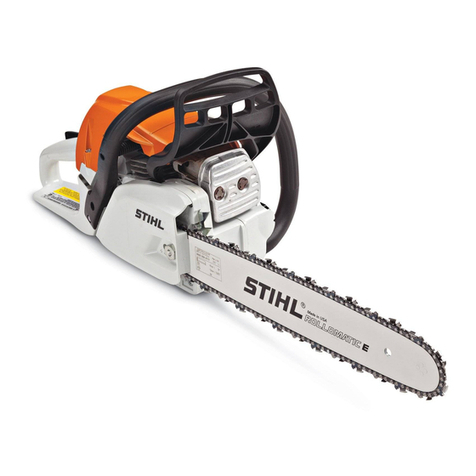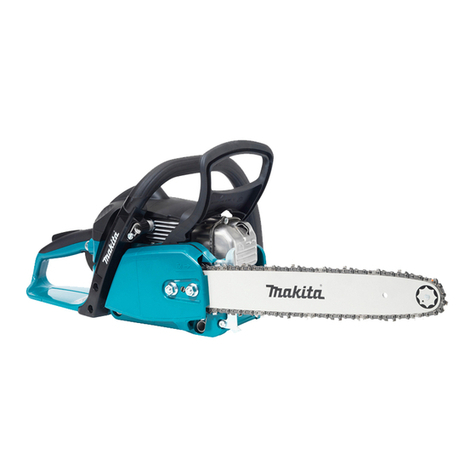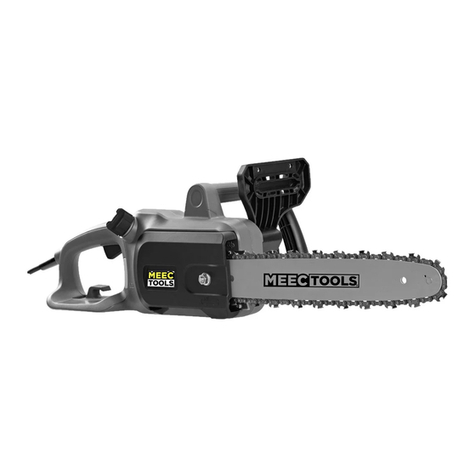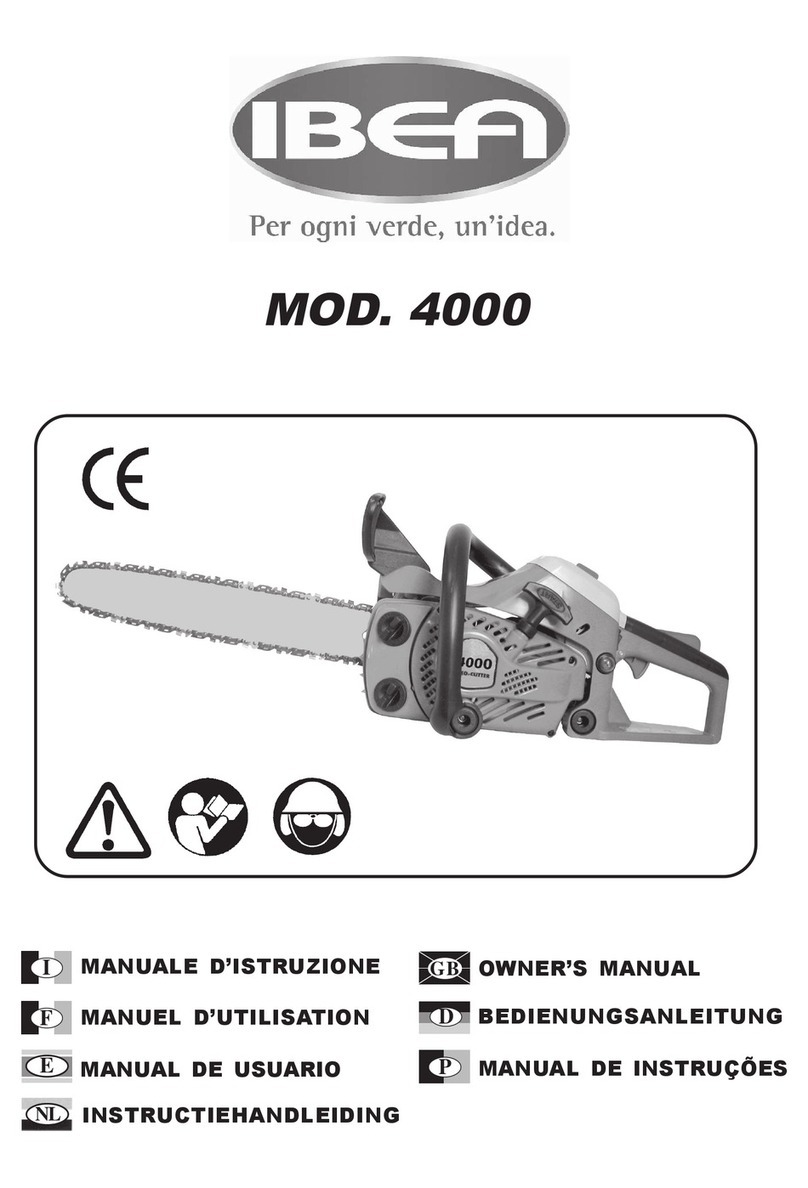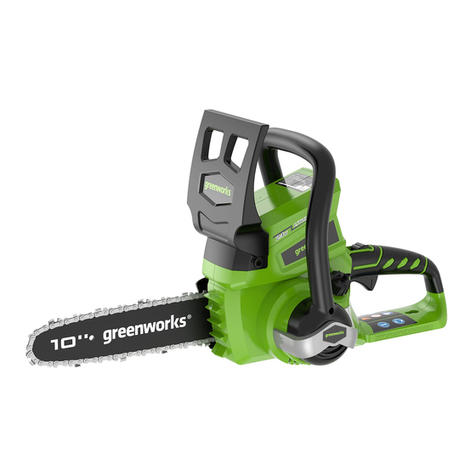PRETUL MOT-6020P User manual

Manual
Chainsaws
Models Codes
MOT-6020P
MOT-6018P
Applies for:
27045
27044
Motor
60 cm3(cc)
CAUTION Read this manual thoroughly
before using the tool.
INGLÉS
ESPAÑOL

2
Contents
ENGLISHENGLISH
Technical Data
Fuel Specifications
General Motor Tools Safety Warnings
Safety Warnings for Chainsaws
Parts
Safety Devices
Fuel and Oil Supply
Bar and Chain Mounting
Start Up
3
3
4
5
7
8
9
10
12
Shut Off
Cutting Operations
Felling and Bucking
Trimming and Pruning
Adjustments and Maintenance
Troubleshooting
Authorized Service Centers
Warranty Policy
13
13
14
16
17
21
23
24
1 liter
of Gasoline
1 L
Mix
50:1
4 oil
capfuls
Use gasoline mixed with 2-STROKE motor OIL.
A wrong mix may cause the chainsaw to throw
a rod, causing expensive repairs!
Do not use a fuel MIX that has been stored longer than 15 days.
Perform periodic MAINTENANCE to your machine (page 17).
ALWAYS operate your chainsaw at MAXIMUM POWER
with the trigger FULLY tightened
CAUTION
Keep this manual for future references.
The illustrations in this manual are for reference only. They might be different from the real tool.
To gain the best performance of the tool, prolong the duty life, make the Warranty
valid if necessary, and to avoid hazards of fatal injuries please read and understand
this Manual before using the tool.
Use and care recommendations

• The chainsaw is built with an air-cooled, 2-stroke motor using unleaded gasoline high quality self-mixing oil with fuel stabilizer
specified for air-cooled 2-stroke motor.
• The motor is certified to function with unleaded gasoline for vehicles with an 87 ([R+M]) octane-rating or higher.
• Do not use any type of pre-mixed gasoline with oil purchased in gas stations, like the one fit for motorcycles.
• DO NOT use automotive oil, nor outboard 2-stroke motor oil.
• The mix ratio shall be 50 parts gasoline per 1 part oil (ratio 50:1). Prepare the mix in a gasoline approved container. Always
mix thoroughly before pouring in the motor tank.
Do not use fuel mix that has been stored more than 15 days. Mix only small amounts.
Never smoke near fuel or the area where gasoline is being filled up nor where the mix with
oil is being prepared or when operating the chain saw.
3
Code
Description
Net Weight (without bar)
Bar Length
Chain Pitch
Chain Gauge
Drive Sprocket Wheel
Motor Cylinder Capacity
Motor Rated Power
Maximum Motor Speed
Chain Speed
Fuel Tank
Oil Tank
Vibration
40 minutes rest per each tank consumed.
Maximum 5 hours daily.
Work Cycle
MOT-6020P
27045
20”
15,2 lb
Chain Saw
0.05”
0.325”
with 7 (0,325”) sprockets
60 cc
12500 RPM
4 330.7 ft/min
19.95 oz
8.79 oz
front handle 3.5 m/s2
rear handle 7.7 m/s2
MOT-6018P
27044
14,7 lb
18”
3 HP
Technical data
Fuel requirements
WARNING
CAUTION
Mix
1 liter
1L+ = 50:1
proportion
4 capfuls oil
Gasoline
Use the cap of oils ** ACES-2, ACES-5 or ACES-20 as a measure to prepare
the mix. Mix 4 capfuls oil with each liter gasoline.
To make the useful life of the motor las longer use synthetic oil for 2-stroke motors.
* 1 gallon = 3,78 liters ** Not included
A wrong mix can cause the machine to throw-a-rod,
causing costly repairs!
ENGLISHENGLISH

4ENGLISH
General Motor Tools
Safety Warnings
Keep your work area tidy and with good lighting.
Cluttered and dark areas can cause injuries.
Never use the chainsaw in explosive environments or
where there are flammable liquids present.
Set the chainsaw 30 ft. away from the fuel filling up
area before starting the motor.
Keep children and passersby at a safe distance while
the chainsaw is operating.
Distractions can make you loose control and
cause accidents.
Avoid making contact with power lines and circuits.
Find and avoid all power lines and circuits, especially
hidden wiring. Also keep away from grounded objects.
Stay always alert, be prudent and use common sense.
Even tough you are familiar with the use of the chainsaw
do not get distracted while operating the machine. It can
cause accidents.
Do not operate the chainsaw when tired or under the
influence of drugs, alcohol or medication.
A moment of distraction while operating the chainsaw
can cause severe personal injury.
Use the chainsaw with the guards and protector
installed and in good repair.
Failure to comply with this warning leads to severe personal
injury.
Never force the chainsaw.
Working within the range designed assures a belter job
and is safer.
Store the chainsaw is a safe place away from the reach
of children.
Chainsaws are dangerous near inexperienced
hands.
Wear the right clothes.
Loose clothing, jewelry or long hair can get
tangled in the moving parts.
Keep your hands away from the rotating or moving
parts.
Failure to comply with this warning leads to
severe personal injury.
Do not use the chain saw in enclosed areas.
To prevent accumulation of carbon monoxide, an
odorless toxic gas potentially deadly.
Use the right personal protection equipment.
Using eye protection, anti-dust masks, non-skid safety
shoes, helmet, hearing protection and safety gloves
considerably reduce the risk of injury.
Turn off the chain saw before adjusting, changing
accessories or storing.
Double-check the chainsaw motor switch is in the OFF
position.
Never run the chain saw if the switch is not working or
is not duly assembled.
The operator is exposed to severe injury. Take it to repair
immediately to a Authorized Service
Center.
Do not overreach.
Good footing and balance give better control of the chain
saw in unexpected situations.
Prevent unintentional starting.
Double-check the chainsaw motor is OFF before
leaving or servicing.
Remove any vise fixed in the chain saw before starting it.
Additional tools or wrenches fixed in a rotating part in
the chainsaw can cause severe personal injury.
Service the chain saw and double-check it is in the best
conditions before starting it.
Check carefully the moving parts. See alignment and
assembly. Do it periodically. Look for damaged elements
or part that is not functioning correctly. Repair
immediately in a Authorized Service
Center.
Accessories.
Use only accessories or spare parts indicated in this
Manual o certified by .
Never leave the concrete chain saw running and
unattended.
To prevent severe accidents turn off the chainsaw after
operating and before setting it in a safe place.
Never smoke near fuel.
Do not smoke near the area where fuel is being supplied
or when operating the chainsaw.
CAUTION CAUTION
WARNING
DANGER
DANGER
CAUTION
DANGER
DANGER
CAUTION
CAUTION
CAUTION
CAUTION
DANGER
DANGER
DANGER
WARNING
WARNING
WARNING
WARNING
WARNING
WARNING
WARNING
ENGLISH

• Remember, safety is a combination of common sense,
alert mind and the knowledge of the tool functioning.
• Read carefully the manual before
starting to use the chain saw. Pay attention to the safety
rules, the alert symbols and the danger, warning and
caution notices in the instructions and in the labels
adhered to the tool. These safety rules are meant to alert
the user and prevent possible injuries that can be fatal.
However, these do not eliminate the danger implied in a
faulty operation of the chainsaw. If the chain saw is used
correctly and only for the specified use, it will deliver
many years of safe and reliable service.
• Familiarize with the chainsaw with the help of this
manual. Save it in a safe and handy place to consult it
frequently and to teach the future chain saw operators.
Learn the uses, limitations as well as the possible specific
risks.
• Chainsaws are designed exclusively
to cut wood. Do not try to cut any other type of material.
• Never allow people lacking the
adequate instruction to operate the chain saw.
• Operate the chainsaw only when visibility and the light
conditions are adequate to see clearly.
Kickback is the sudden and strong movement outwards
from the cut and in the operator direction of the running
tool. It can cause the operator loses control and cause a
severe body injury. Usually it is caused when the nose of
the bar touches an object or the cutting chain is caught in
the material about to be cut. To prevent kickback, take the
following caution measures:
• Keep all the guards and safety devices incorporated to
the chain saw in place and in good repair.
• When operating the chain saw stay alert and do not
allow being used to the use of the machine make you pay
less attention while using the tool.
• Use both hands to hold the chain
saw firmly when the motor is running. Set the right hand
in the rear handle and the left hand in the front handle.
Both handles shall be grasped with the fingers, having the
thumbs bent below the handles (A). This way of grasping
has less possibility to fail in case of a kickback. Keeping
the thumbs in the same side of the fingers is dangerous
because it lessens greatly controlling the chain saw in case
of kickback.
• Operate the chainsaw setting the left arm rigid and
totally extended.
• DO NOT make contact with the chain
bar nose and the material to be cut or any other obstacle
like trunks, branches, fences or any other thing it can hit
when operating the chainsaw.
• Always cut with the motor running its maximum speed.
Press fully the throttle trigger and keep a stable cutting
speed.
• Do not try to reach or cut objects that
are out of reach or above chest height.
• Keep the cutting chain well-honed and in optimal
conditions.
• Use only spare bars and chains specified by
.
• Never smoke close to fuel, nor in the gasoline fill up
zone or where the mix with oil is being prepared or
when operating the chain saw.
• To reduce the risk of fire or burns handle fuel with
care. It is very flammable.
• Use care with oil and gasoline. Prevent your skin having
contact with these.
• Protect your eyes to prevent spills of gasoline or oil. In
the event of accidental contact wash eyes immediately
with clear water. If irritation persists go see a doctor.
• Mix and store fuel in a dedicated gasoline container.
• Mix fuel outdoors away from sparks or flames.
• Before supplying fuel to the chain saw turn off the
motor and wait until the motor cools down.
• Before operating the chain saw, wipe clean all the fuel
that could have spilled in the chain saw.
• Check for fuel leaks. Correct any leak before using the
chain saw to prevent fire of burn injuries.
• Stay away from the filling up area at least at a 9 meters’
distance (30 feet) away before starting the motor.
• Never, ever burn spilled fuel to eliminate it.
Right way to hold
the chainsaw
Wrong way to hold
the chainsaw
5
General To Prevent Kickback
Fuel Handling
A
WARNING
WARNING
CAUTION
DANGER
DANGER
DANGER
Safety Warnings for
Chain Saws
ENGLISH

• Never operate the chain saw
single-handedly. Otherwise, the operator and all the
people present can get injured.
• Keep every part of your body away from the chain when
the motor is running.
• Keep every part of your body away from the muffler.
Otherwise it can cause severe burns.
• Do not cut vines or too small undergrowth (smaller than
3” diameter).
• Use extreme caution when cutting
small undergrowth and young trees. The thin material can
get caught in the chainsaw’s chain and get thrown against
you with force.
• Use extreme caution when cutting
branches caught under pressure. When cutting, the
branch can go back with strength to its original position
and in its trip hit the operator. Consider this measure to
be all the time out of the reach of the branch.
• Keep your attention focused to the
chain saw reaction when cutting large logs. Due to the
force of reaction the chainsaw can be pushed towards the
operator (B) or pulled towards the trunk (C) as per the
movement direction of the chain and depending on the
cutting bar edge (upper or lower) that is being used to
cut.
• Keep all the work colleagues at a safe distance from the
chainsaw while starting it or operating. A safe distance is
15 feet between the workers.
• Double check the passersby or animals are even farther
away from the work area before starting and operating
the chainsaw. A safe area is at least double than the tallest
trees’ height in the felling zone.
• Make sure the cutting chain is not making contact with
any object before starting the motor.
• Keep both feet firmly supported on
the ground. Do not operate the chain saw if standing on
an unstable surface like ladders, scaffold, trees, etc. Only
highly qualified staff can operate the chain saw up in a
tree and with the adequate safety equipment.
• Do not start cutting until having the work area clear,
good footing on the ground and an escape route
considering the trajectory the falling tree will take.
• Never use the chainsaw when tired, ill
or under the effects of any drug, alcohol or medicine.
• Wear adequate clothes to operate the chain saw:
Tight clothes, thick slacks, non-skid safety boots,
heavy-duty gloves, safety glasses or protective eyeglasses
with side protection under ANSI Z87.1 standard; hearing
and head protection. Overalls, jeans and chaps as well as
wide-vision full mask are recommended.
• Remove any accessory or loose
clothing that could get trapped in the moving cutting
chain. Pick up your hair so it stays above your elbows.
• Double check the chainsaw is in perfect working
conditions. Do not turn on is badly adjusted or not fully
assembled so it can run in a safe manner.
• Make sure the cutting chain stops moving when
releasing the throttle trigger. In the event the chain does
not stop, adjust the carburetor (page 20). If after adjusting
the carburetor the chain is not stopping when the throttle
trigger is released, turn off the chain saw and take it to a
Authorized Service Center to solve
the problem.
• Do not turn on the chainsaw if finding in it any
accessory or device not specified in this Manual.
• Double check the chainsaw handles are clean, dry and
free of oil or fuel.
• Confirm the work area is open and well ventilated.
• Always carry the chainsaw with the
motor off and the cutting chain brake enabled; the cutting
bar backwards and with its scabbard and the muffler away
from the body.
• Shut off the motor and enable the
chain brake before setting the chain idle. DO NOT leave
the motor running unattended.
• Service and repairs in the chainsaw
shall be carried out only by highly trained personnel. A
poorly performed service job can cause an accident with
fatal consequences. For example, if inadequate tools are
used to dismount or support the wheel to remove the
clutch can cause a structural damage and it may burst.
6
Before operating the chain saw
When Operating the Chainsaw
After Operating the Chainsaw
B
C
WARNING
WARNING
WARNING
WARNING
CAUTION
CAUTION
CAUTION
DANGER
DANGER
DANGER
Safety Warnings for
Chainsaws
ENGLISH

7
Primer
Bulb
Primer BulbFuel Tank Cap Chain Oil Tank Cap
Muffler
Jack-Line
Trigger
Release
Spark plug key
Switch
Throttle
Trigger
Fuel
Tank Cap Rear
Handle Base
Ventilation
Slots
Chain Oil
Tank Cap
Chain
Catcher
Chain
Catcher
Bar
Assembly
Nuts
Bar and
Chain
Housing
Trigger
Release
Choke
Lever
Choke
Lever
Rear
Handle
Chain
Lubrication
Orifice
Air Filter
Cover Lock
Air
filter
Front
Handle
Front
Handle
Jack-Line
Guide Bar
Bar
Scabbard
Hand Front
Protection
Hand Front
Protection
Parts
Rear View Front View
Chain Tension
Adjustment Screw
Bumper
Spikes
ENGLISH

• The chain brake (A) function is to swiftly stop the chain
displacement and protect the hand if kickback strikes (see
page 5). It is designed considering the predictable
kickback movement that throws the chain bar upwards
and towards the operator, so that when the brake is
pushed with the left hand, the chain stops immediately.
• Test the chain brake each time you
turn on the chain saw and before starting the cut:
• With the motor running and pressing the throttle trigger
push with the back of your left hand the chain brake
towards the chain bar. Upon doing this
maneuver DO NOT release the front handle. Only turn
your left hand forward until making contact with the brake
and push it.
• If by any chance the brake would not stop the
chain DO NOT operate the chain saw. Turn it off and take it to a
Authorized Service Center for repairs.
• If the brake works correctly the cutting chain will stop immediately.
To set the brake back into the running position, pull the brake lever
towards you un hearing a click.
• Remember the chain brake will not prevent a
kickback. It is a safety device to prevent possible injuries after a
kickback is produced.
• Remember that even with adequate
maintenance and used in field use conditions, the chain brake
functioning cannot be considered totally safe. Stay alert at all times.
Use adequate cutting techniques and always use all the safety
devices.
• This type of chain is built with cleaning sprockets (depth gauge) set
in front of each cutting sprocket to prevent the sprockets entering too
deep in the wood and get jammed generating a kickback.
• Use only chains certified for moderate kickback
to substitute worn chains.
• Consider that to the extent the chain wears out
with regular use, or the honing process loses the capability to lessen
the possibility of kickback, the use shall use more caution.
• Replace the guide bar (C) with and identical
brand bar.
• The lower the chain bar’s tip radio is, its capacity
to diminish the possibility of a kickback will be lower.
Turn the lleft
hand to activate
the chain brake
8
Guide Bar
Chain Brake
Cutting Chain with Moderate Kickback (B)
A
C
B
K
i
c
k
b
a
c
k
WARNING
WARNING
WARNING
WARNING
WARNING
WARNING
CAUTION
CAUTION
CAUTION
Safety Devices
ENGLISH

9
Fuel and
Oil Supply
• Follow the Safety Warnings for handling fuel
(see page 5).
• Lay down the chainsaw on its side so that the
fuel and oil caps face upwards.
• Wipe clean the surface of the fuel tank cap to
prevent contamination.
• Slowly loosen the fuel tank cap.
• To prevent spilling, use care to pour the fuel
mix into the tank. Follow the
fuel specifications (See page 3).
• Before covering the fuel tank check and wipe
clean the joints.
• Set immediately the fuel tank cap. Hand-tigh-
ten the cap.
• Wipe clean all the fuel spillage.
• Use oil specified for bars, chains and the lubrication
systems, especially formulated to perform in a wide range
of temperatures without the requisite of dilution. (similar
to SAE 15W-40 or SAE 10W-30)
• Add oil per each of fuel tank consumed.
• Do not use dirty, used or contamina-
ted oil. The oil pump, bar or chain may get damaged.
• Lay down the chainsaw on its side so that the fuel and
oil caps face upwards.
• Wipe clean the surface of the oil tank cap to prevent
contamination.
• Slowly loosen the oil tank cap.
• Use care to prevent spillages in the tank.
• Before covering the oil tank check and wipe clean the joints.
• Set immediately the oil tank cap. Tighten by hand.
• Wipe clean all the oil spillage.
Fuel Supply for the motor
Oil Supply for The Bar and Cutting Chain
CAUTION
CAUTION
ENGLISH

• Never start the motor without
installing the guide bar first (A), the cutting chain (B) and
the bar guard (C). If these parts are not in place the user
is exposed to severe injuries.
• Set the switch in the OFF position.
• Pull the chain brake backwards (D) to assure it is in
working position (see page 8).
• Wear heavy-duty protective gloves to
manipulate the chain safely and prevent cuts.
• Remove the nuts (E) with a 1/2” combination or hex key.
• Remove the bar guard.
Cog
wheel
Traction
sprockets
Straighten
Displacement Direction
Cutting
sprockets Advancement
Slot
Advancement
Chain bar
Bar and Chain Mounting
10
• Extend the chain onto a flat and clean surface in an oval
shape, together with the chain bar and straighten any
twisted link. The cutting sprockets shall face the chain
displacement direction, otherwise reverse the chain
position.
• Set the bar onto the mounting bolts in the chain saw.
• Set the chain linking it onto the cogwheel.
• Set the chain traction sprockets around the bar slot.
CAUTION
WARNING
A
B
C
E
D

• Lift the bar with the chain and fix it to the chainsaw passing the mounting bolts (F) through the bar slot and the
loose-fitting space between the bar and the chain and around the brake (G) so that the sprockets fit into the spaces in the
cogwheel (H).
• Mount the housing. Double check you introduce the chain tension pin. Hand tighten the mounting nuts so that the bar
can move freely forward and backward until the chain tension pin fits into the bar lower orifice ( I).
Loose Chain
Adjusted Chain
Right Tension with
a Distended Chain
Bar and Chain Mounting
11
Tensing the Chain
• Use a flat screwdriver to turn the chain tension
screw (J) until the chain gets adjusted to the bar
without any looseness and with the traction links
inserted in the bar slot.
• Lift the cutting bar nose to verify if there is still some
looseness in the chain. If that is the case, turn again the
tension screw 1/2 turn. Repeat the procedure until there
is no looseness between the chain and the bar.
• Keep the cutting bar nose risen while tightening the
nuts with the key.
• To verify the chain is not too tight try moving it with
your hand. If the chain gets stuck or is difficult to move
loosen the mounting nuts again and turn the tension
screw only 1/4 of a turn. Lift the bar nose and tighten
the mounting nuts before checking back the chain tension.
• To check the tension in the chain when heat produced while cutting has
distended it, the flat nose of the spark plug key shall be inserted between the
bar lower side and one of the chain link to verify the looseness is 0,05” (A).
A
0,05”
I
J
G
H
F
ENGLISH

12
Start Up
• Set the chainsaw onto a leveled ground where the bar
and change make no contact with the ground or any
other object.
• Firmly hold the front handle with your left hand, set the
right foot onto the rear handle base (A).
• Pull the chain brake backwards to double check it is in
the functioning position ( see page 8).
• If the chain starts while the brake is
activated the chainsaw may be seriously damaged.
• Set the switch into the ON position (B).
• Press completely and release the starter choke 6 times
(C).
• Pull the choke lever all the way out (D).
• Pull the jack-line (E) until the motor seems to start, but
no more than 3 times if the environment temperature is
higher than 50 °F. If the temperature is lower, pull the
jack-line until the motor starts.
• EPush the choke lever to the bottom (F).
• Pull the jack-line back (E) until the engine starts.
• Once the motor starts leave it running 30 seconds in
that position.
• Press and release the throttle trigger to run the motor
idle (G).
• The chainsaw is now ready to cut. Hold it by both
handles in the right position (see page 5) and lift it to start
working.
Motor Start Up
CAUTION
B D
F
C
C
G
x6
A
D
ENGLISH

Cut Axis
13
Shut Off
Cutting Operation
Shutting Off the Motor
• Release the throttle trigger and leave the motor running slow.
• Set the switch into the OFF position (H).
• Allow the chain to stop before setting the chainsaw onto the ground.
• To gain an additional degree of safety set the chain brake (I) when
not using the chain saw.
• If the chain has not stopped despite being in the OFF
position, pull the choke lever completely outwards (figure
Din page 12). Activate the chain brake to shut off the
motor. Go to a Authorized Service
Center to carry out repairs in the switch before using again
the chainsaw and prevent unsafe working conditions and
possible severe injuries.
• Once the chainsaw is off release
pressure in the tanks. Loosen the caps of both the oil and
fuel tanks. Then tighten the caps back.
• Leave the motor cooling down before storing the unit.
Basic Cutting Procedures
If the user has no previous experience in the use of chain
saws, practicing with small logs (not smaller than 7,9”
diameter) is recommended. Support the log onto a
sawhorse to get familiar to using the saw. Follow the
following technique:
• Adopt the right position in front of the log with the chain
saw running slow.
• Press the throttle trigger to make the motor reach its
maximum speed.
• Start the cut setting the chain bar onto the log.
• Keep the motor in its maximum speed at all times.
• Allow the cutting chain do its job applying slight
pressure downwards with the chainsaw. Do not try to
force the cut at any time, otherwise the chain, the bar or
the motor could get damaged.
• Release the throttle trigger as soon as finishing the cut.
This way the motor will run slow avoiding unnecessarily
wearing out the chain, bar or motor.
Right Position for Cutting
• Both feet shall be supported on firm ground. Body
weight well balanced. The left foot shall be slightly
forward of the right foot.
• Hold the chainsaw as indicated in the Safety Warnings
for chainsaws’ section (see page 5).
• Keep the left arm straight. Do not bend the elbow to
support in the event a kickback force sets.
• Always keep cutting axis on your right side, in order that
your body is away from the cutter axis in a
kickback situation.
• Hold the chainsaw close to the body to prevent tension
in arms and back.
• Do not try to hold the chainsaw left-handed.
I
Cut Axis
Left
arm straight
Cut Axis
CAUTION
H
Saw
Horse
ENGLISH

Debris Area
First Cut
Third
Cut
Notch
Wedge
Bisagra
Second Cut
45°
40°
180°
45°
Felling and Bucking
14
Preparations for felling trees
• Plan ahead at least two escape routes and clear the area
to prevent blockages. The optimum escape route is a
180° off the trajectory calculated for the felled tree with a
45° margin towards both sides.
• To calculate the fall of the tree, consider
the wind direction and strength, inclination
and balance of the tree and the placing of
its larger branches.
• Double heck the tree has no dead
branches that could fall over the operator
while cutting.
How to cut a tree
• Cut a notch 1/3 diameter of the trunk in the side
calculated it will fall.
• This notch shall be made through two cuts. The first
one horizontal and the second one at 40°
• It is important to make the cuts in the
previously mentioned order to prevent a piece of residual
wood lean on the chain bar and trap it or shoot it with
force into an undetermined direction.
• The third cut shall be made in the opposite side of the
notch. It shall be horizontal and shall stay 2” minimum
above the horizontal notch but not getting to it. Between
the notch and the third cut there shall be a 1/10 distance
off the trunk diameter to make a hinge that will control
the fall of the tree. This way unexpected movement or
trajectory is prevented while it falls or the violent
separation of the tree from its stump.
• Never make the third cut up to
reaching the notch. Otherwise the tree could fall out of
control.
• When cutting trees with a large diameter stop the rear
cut before reaching such a depth that it makes the tree to
be settled and trap the chain bar.
• Before going on with the cut insert little by little wooden
or plastic wedges in the cut to keep it open.
Restrictions for felling trees. Do not try it for any reason!
• Do not cut trees under rain or strong winds. Wait to the weather to calm down.
• Do not cut tress with people or animals in the zone. The safe distance for passersby is explained in the section “When
operating the Chainsaw” in the Safety Warnings for using chain saw in page 6.
• - Do not cut trees if the felling line has not been previously calculated. Avoid being crushed by a falling tree!
• Do not cut extremely thin trees.
• Do not cut big trees with rotten branches, loose bark or hollow trunks. Heavy
-duty pushing or dragging equipment operated by professionals is needed.
• Do not cut trees close to electric wiring or buildings.
Felling Trajectory
Optimum Escape
Limits for tree felling. Leave this jobs for the professionals!
E
s
c
a
p
e
M
a
r
g
i
n
• Inserting the wedges can be enough to make the tree
fall. Otherwise the anti-kickback guard in the chain bar
nose shall need to be disassembled to insert it in the
cut without removing the wedges and continue
until a wedge is made.
• Install again the anti-kickback guard
as soon as finishing the cut.
• When the tree starts falling, shut off the chainsaw and
set it onto the ground immediately. Use the optimum
escape route to get away. Do not stop paying attention in
the event of an eventuality.
• While making the third cut watch the
three crown constantly. Double check the fall keeps going
in the planned direction. If for any reason the tree starts
falling in the wrong direction or the chainsaw gets trapped
leave it behind and run for dear life!
F
a
l
l
i
n
g
T
r
a
j
e
c
t
o
r
y
1/3 of
the Trunk
1/10 of the Trunk
2”
CAUTION
CAUTION
WARNING
WARNING
ENGLISH

• On very thick trunks is advisable to insert wedges into
the cut to prevent the chain bar getting trapped in the
trunk when it sits into place while being cut.
• If the trunk diameter is too big disassemble the
anti-kickback guard from the chain bar nose to insert it
into the cut without removing the wedges and continue
the job.
• Install back the anti-kickback guard as
soon as finishing the cut.
• Bucking is the tree trunk cutting after being felled.
• When bucking always cut one trunk at a time.
• Support small trunks onto a saw horse or between two
bigger trunks put together to cut.
• If in the bucking area the ground is
not leveled, stand always in the highest level while cutting
to prevent the cut parts rolling upon you.
• Stay alert at all moments.
Sometimes is hard to predict the direction the trunks will
take once being cut. It is not possible to always prevent
the chain bar get trapped by the trunks.
First Cut
Second Cut
Residual Part
(Anchor Root)
Saw
Horse
Wedge
Load
Felling and Bucking
15
Cutting Anchor Roots
• Anchor roots are those that stick out too much from the
trunk above the ground. When these roots are too big can
make felling a tree very difficult. The anchor roots need to
be removed before felling the tree.
• First, make a horizontal cut through the roots, a couple
of centimeter from the ground.
• Then, make a vertical cut downwards and leveled to the
trunk to separate the root without trapping the chain bar.
• It is important to make the cuts in
the previously mentioned order to prevent a piece of
residual wood lean on the chain bar and trap it or shoot it
with force into an undetermined direction.
Bucking
Bucking with a Wedge
• Make first a 1/3 deep cut with regards to the trunk diameter. Finish with a second 2/3 deep cut in the opposite side. Se the
diagram to determine where to make the first cut preventing the chain bar gets trapped by the trunk when binding due to its
own weight.
Bucking Trunks Under Pressure
First cut (1/3)
Final cut
Final cut
First cut (1/3)
CAUTION
WARNING
WARNING
WARNING
Load
ENGLISH

Bucking Above
the Trunk Bucking Below
the Trunk
Reaction Reaction
16
Felling and Bucking
Trimming and Pruning
T
e
n
s
i
o
n
R
e
l
e
a
s
e
Bucking Above the Trunk
• Start cutting in the upper part of the trunk setting the
lower side of the chain bar against the trunk.
• Exercise slight pressure downwards.
• Beware of the chain saw reaction. The
reaction force will pull the chainsaw towards the trunk.
• Similar to the felling job, trimming and pruning shall be
made using calm, extreme care and following the Safety
Warnings (see pages 5 and 6).
• When cutting a branch, the tree shall be between the
operator and the cutting chain.
• Never cut branches using a ladder,
hanging from the tree or standing in a platform or trunk.
It is extremely dangerous! Call a professional to handle
the branches that are out of reach when standing on the
ground and that are above your chest height.
Bucking Below the Trunk
• Start cutting in the lower part of the trunk setting the
upper side of the chain bar against the trunk.
• Exercise slight pressure upwards.
• Beware of the chainsaw reaction. The
reaction force will pull the chain saw towards the operator.
Cutting Operation
• When cutting a branch do not cut flush to the trunk to
prevent that the branch when falling will rip the trunk’s
bark.
• Make the first cut 1/3 deep with regards to the branch
diameter. Then, make a second 2/3 cut in the opposite
side.
• Finish the cutting the branch with a third cut flush to the
trunk to allow bark growth and sealing the cut.
• If the branch is too big cut sections to prevent a violent
detachment.
Poles
• Pole is a trunk, branch or young tree been bent by
another trunk or branch pressure accumulating tension
which is released with great force if the pressure is
released.
• Poles are very dangerous because can
hit the operator causing severe injuries and / or losing
control on the chain saw. Stay always alert to this
possibility.
First cut (1/3)
Pole
Final
cut
Second cut (2/3)
Load
CAUTION
CAUTION
DANGER
DANGER
ENGLISH

Cutting Chain Maintenance
Chain Honing
• The chain need honing if the wood shavings generated
when cutting are small and dusty, when forcing the chain
bar through the wood is necessary to make the cut or
when the chain cuts sideways.
• The chain honing shall be carried out having it mounted
and tense in the chain bar (see page 11) and with the
chain saw motor off.
• Use a round file with a 5/32” diameter.
• Be careful and file all the sprockets in
the angles specified in the image and the same length
specified. Only with uniform sprockets an adequate and
safe cut is accomplished.
• File one by one all the sprockets. First all in the right side
and then all in the left side. To pass from one sprocket to
the other go through the chain only a little bit so each
time you file one sprocket you do it onto the middle of
the chain bar.
• Keep the file leveled to the sprocket upper plate. Avoid
tilting or balancing the file. apply soft but firm pressure
moving only towards the front of the sprocket. Separate
the file from the sprocket in each return movement.
• Give only a few passes on each sprocket.
• Using a wire brush remove the steel shavings produce
while shaving.
• Operating the chain saw with a poorly
honed or dull chain can damage the motor due to the
excessive speed.
• Operating the chain saw with a
damaged chain can cause severe injuries.
• The cutting chain is very sharp. Use
heavy-duty protective gloves to handle it.
• If the cutting chain is dull due to
contacting nails or stones or due to mud or sand present
in the wood, take it to a authorized
Service Center to be professionally honed.
• So that the chainsaw makes fast and smooth cuts, the
chain need periodical and adequate maintenance.
• Turn off the chainsaw before carrying out any
maintenance task.
• Wear heavy-duty protecting gloves.
17
Adjustments
and Maintenance
Top
Plate Top
Plate
Right
Sprocket
Cutting
Sprocket
Cutting
Sprocket
Left
Sprocket
Toe
Chain Axis Chain Axis
Chain direction
Rivet
Depth
Gauge
Gullet Gullet
Side
Plate
Side
Plate
Heel Heel
Toe
Depth
Gauge
Right cutting link
Right Honing
angles of the
Cutting Sprockets
Honing
Direction
Left cutting link
30°
30°
60°
Any other angle different to the
specified lessens the cut quality, damages the motor, the
bar and chain and increases the risk of a violent kickback.
CAUTION
CAUTION
CAUTION
WARNING
WARNING
WARNING
ENGLISH

Advancement
Depth Gauge
of the Cutter link Depth
Gauge
Flat
File
Depth Gauge
Jointer
Adjustments
and Maintenance
18
A
Chain Depth Gauge
Chain Bar Maintenance
• The chain is built with drive sprockets (depth gauge)
placed in front of each sprocket. These prevent the
sprockets enter too deep in the wood and get stuck
generating kickback.
• Depth gauge shall be checked each time the chain is
honed to verify the sprockets have the right height with
regards to the drive sprockets upper plate.
• The difference in height of the depth gauge and the
sprockets shall always be 0,025”.
• When due to normal wear and / or honing the chain,
the difference is lower, use a depth gauging instrument
and a flat file to make even and verify the difference to
0,025”.
• File only the depth gauge. File in the same direction you
filed the adjacent sprocket. Use care and do not touch the
cutting tip.
• After making even the difference in all the drive, file
each sprocket one by one to give them back the original
shape making the front round (A).
• The chain bar shall be cleaned at the end of the cutting
journey. Also, checked thoroughly to identify wear or
possible damage.
• Apparition of small grooves and lumps in the bar rails
are caused by the chain saw normal use. Make them
smooth with a file as soon as identified.
• Clean all debris from the lubrication orifice and the
cutting chain slot.
• After a week’s work reverse the chain bar to distribute
the normal wear and make its useful life longer.
• After a week’s work lubricate the chain bar if it has a
cogwheel in the nose. Use a grease syringe to apply
lubricant in the lubrication orifice.
• If the rail shows wear do not leave the chain
resting on its side, do not allow it to be
widened or that the chain bar is
bent. Replace the complete bar
with a new one.
0,025”
ENGLISH

19
Air Filter Cleansing
• Loose the lock and remove the air filter cover.
• Then pull the choke lever completely outwards to
prevent contaminating the carburetor during the cleaning
process.
• When removing the air filter use compressed air or a
brush in the uncovered area to eliminate soil and sawdust
as much as possible.
• Remove the air filter pulling upwards.
• Use a flat screwdriver to separate both sections of the air
filter.
• Reliant on the use time, clean the filter superficially only
tapping it against a smooth and flat surface to dislodge
most of the sawdust and dust particles.
• The air filter can also be cleaned with compressed air.
Clean on both sides.
• For a more complete cleansing wash the air filter with a
soapy solution, rinse and let dry completely before
installing back in the chainsaw.
• If using compressed air to dry it, blow air on both sides
of the filter.
• Set back the air filter. Verify it ties and rest perfectly in
the base before setting the cover and lock.
• Check periodically the fuel filter. If contaminated or
damaged, go to a Authorized Service
Center to replace it.
General Cleaning
• Using a brush or compressed air clean and clear the
ventilation slots in the starter unit each time is necessary.
• Likewise, clean periodically the blades in the motor
cylinder and the ventilator blades to remove dirt.
Otherwise the motor can get damaged due to
overheating.
• Depending on the type of fuel and oil used, or the
particular functioning conditions, the exhaust orifice and
the muffler can be obstructed with coal deposits. If the
chain saw shows loss of power in the chain saw it will be
necessary to eliminate such deposits to restore
performance. Take the chain saw to a
Authorized Service Center to carry out this service.
Carburetor Adjustment
• Adjusting the carburetor shall only be
carried out by the Authorized Service
Center specialists.
• Before they carry out the adjustments to the carburetor
verify the air filter and the ventilation slots in the starter unit
are clean (see page 19).
• The motor shall be warm before any adjustment to the
carburetor.
• The carburetor is shipped from the factory already
adjusted. It only admits limited adjustment to the “L”
nozzle (moderate injection) and “H” (intense injection)
within a 1/2 turn range. Do not force the nozzles beyond
the range to prevent severely damaging the motor.
• The nozzles are inside the upper orifice in the motor
cover marked with an “L” and an “H” in one side of the
jack line. There are plastic caps that prevent turns to the
left with regards to the original adjustment.
Chain Brake
• Remove the bar housing. Inspect and clean the chain
brake components. Look for wear in the brake band.
Replace it if worn to half of its original thickness 0,035” or
if malformed.
• Always keep clean and lightly oiled the chain brake
mechanism.
• Check the chain support and replace if damaged.
• Never try to start the motor
WITHOUT assembling first all the chain saw parts.
Otherwise the parts can get fractured and shoot
out towards the operator. Can also damage the
chain saw and make the Warranty void.
CAUTION
WARNING
Fuel Filter
Exhaust and Muffler Cleansing
• Depending on the type of fuel, the amount of oil used
and / or the conditions the tool is used, the exhaust and
muffler can get clogged with carbon deposits. If you
notice loss of power remove those deposits to restore
performance. Go to a Authorized
Service Center to carry out this service.
• The muffler is built with a spark arrest screen inside the
muffler. After being used long periods of time the screen
gets soiled and the muffler has to be replaced. Go to a
Authorized Service Center to replace.
Adjustments
and Maintenance
ENGLISH

• The motor need a Bosh L8RTF spark plug with an electrode gap of 0,025”. Replace the spark plug with a similar new one
at least every six months.
• To replace the spark plug, remove the motor cover (see page 19).
• Using a special wrench turn left and loosen the worn spark plug and remove it.
• Insert the new spark plug. Tighten left using your hand.
• Use care to prevent damaging the spark plug thread. Otherwise the motor gets seriously damaged.
20
Chainsaw Storage
When storing the chainsaw one month or longer,
consider the following:
• Drain all the contents of the fuel tank into a dedicated
gasoline container. All the remaining oil can be used in
another 2-stroke motor needing a 50:1 ratio.
• Run the motor until consuming all the fuel and it turn
off. This way the residual fuel will be eliminated and will
prevent gum residues that damage the fuel system.
• Drain all the oil tank contents off the bar and chain. Use
a dedicated container for oil.
• Clean the chainsaw thoroughly.
• Store the unit in a ventilated space away from corrosive
agents like corrosive garden chemicals or de-icing salt.
Also, away from children reach.
• Comply with all the government rules regarding safety,
handling and storing fuel.
Slow speed Adjustment
• The slow speed screw is inside the lower orifice in the
motor cover and marked with a “T” in one side of the
jack-line.
• If the motor starts, runs and accelerates but cannot run
idle, turn to the right the idle screw so that the motor can
run idle.
• If the chain advances with the motor set in idle, turn the
idle button to the left to reduce the speed so that the
chain will nor advance.
• If the chain still moves when the motor is in idle speed
after adjusting the screw, turn off the chain saw, stop
using it until is adjusted in a Authori-
zed Service Center.
• Using the chain saw whit the chain
moving when idle can cause severe personal injuries.
Spark Plug Replacement
CAUTION
DANGER
Adjustments
and Maintenance
ENGLISH
General Cleaning
After
each use Every
25 h Every
50 h Every
150 h Every
250 h
Air filter cleaning
Carburetor cleaning *
Spark plug inspection and adjustment *
Fuel tank cleaning **
Fuel filter change **
Fuel hose replacement **
Spark arrester cleaning
Periodic Maintenance
** Authorized Service Center.* Trained user or Authorized Service Center.
This manual suits for next models
3
Table of contents
Other PRETUL Chainsaw manuals
Popular Chainsaw manuals by other brands

Tanaka
Tanaka TCS 33EDTP instruction manual

Westfalia
Westfalia 87 74 50 instruction manual

Maruyama
Maruyama MCV31R Owner's/operator's manual
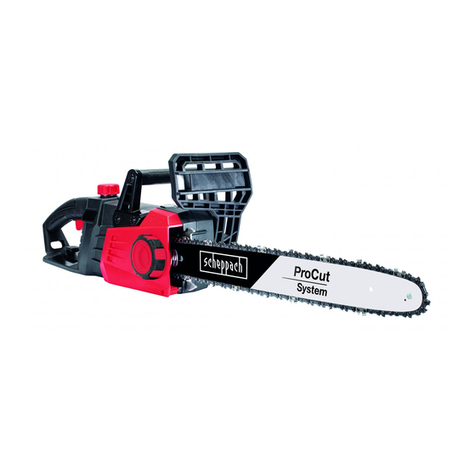
Scheppach
Scheppach CSE2700 Translation of original instruction manual
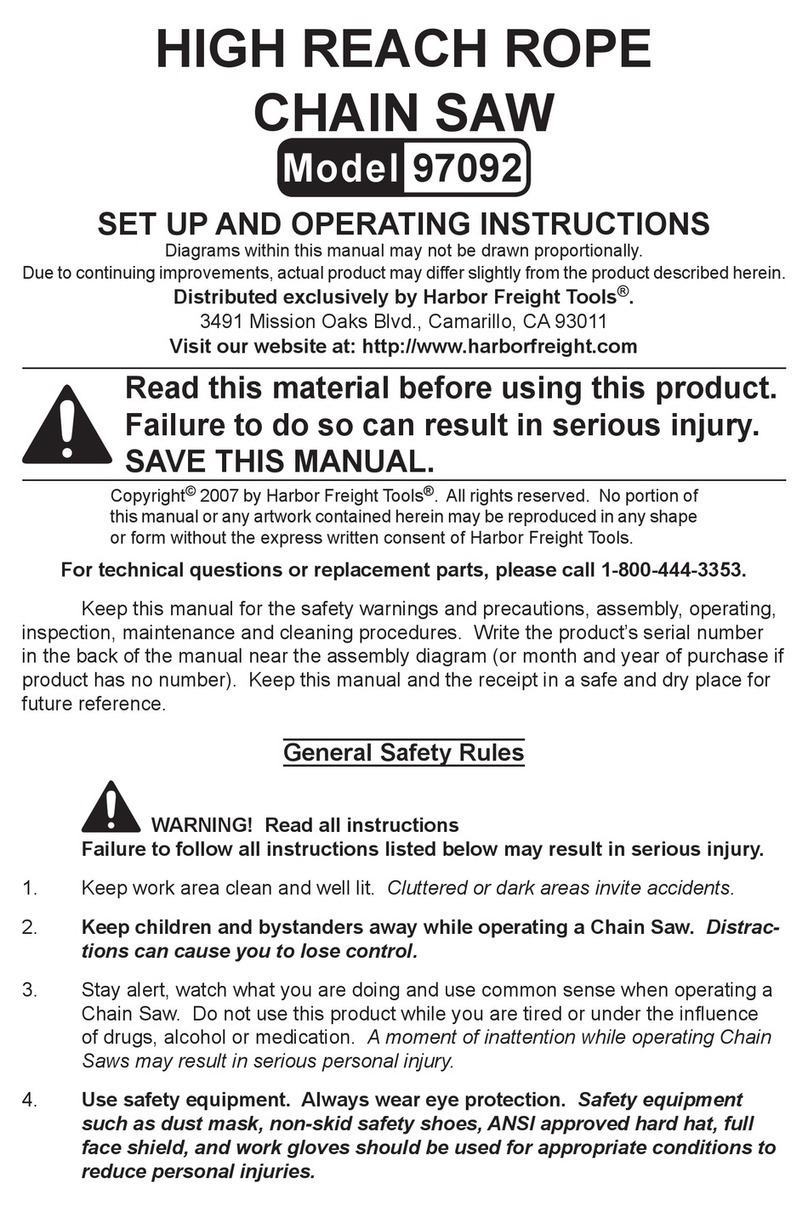
Harbor Freight Tools
Harbor Freight Tools 97092 Set up and operating instructions
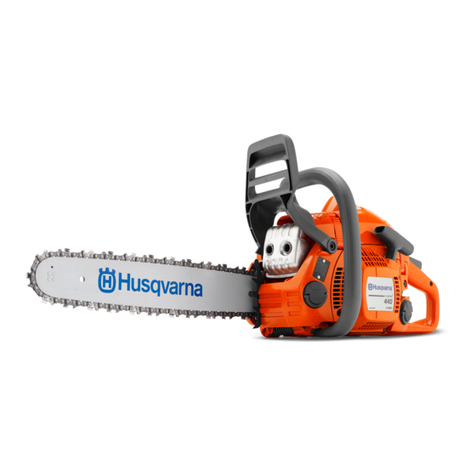
Husqvarna
Husqvarna 440e II Operator's manual






